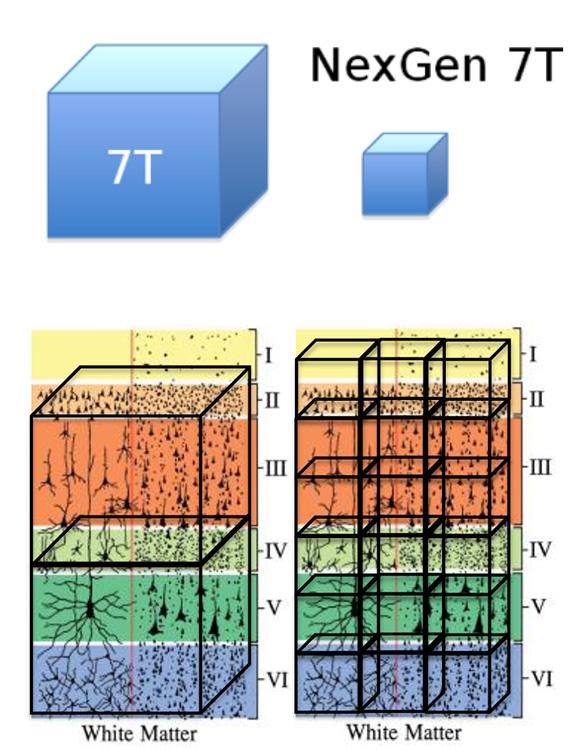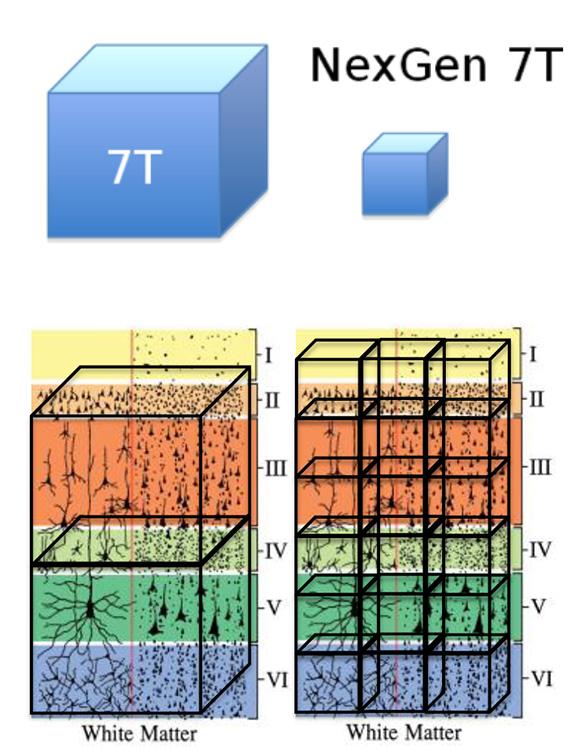
Credit: David Feinberg/UC Berkeley
Functional magnetic resonance imaging, or fMRI, has transformed our view of the brain, allowing researchers to pinpoint areas associated with everything from depression and dementia to playing chess and engaging in sex.
Its key limitation, however, is resolution: Even the most powerful scanners, using strong 7 to 10 Tesla magnets (7T to 10T), can often only localize activity within a region measuring several millimeters on a side – the size of a grain of rice – that comprises some 100,000 individual neurons doing a variety of different things.
To zoom in on smaller groups of neurons, University of California, Berkeley researchers have reimagined fMRI techniques and instruments to boost the resolution by a factor of 20. They will use a new $13.43 million BRAIN Initiative grant from the National Institutes of Health to build the NexGen 7T by 2019 to provide the highest resolution images of the brain ever obtained, able to focus on a region the size of a poppy seed.
"Our innovation in MRI technology requires a total redesign of nearly all of the scanner components, not just an incremental change," said lead researcher David Feinberg, an adjunct professor in the Helen Wills Neuroscience Institute at UC Berkeley and president of Advanced MRI Technologies. "The much higher resolution imaging will overcome size barriers in imaging the cortex and should lead to new discoveries in the human brain, hopefully with major medical impact."
With the ability to pinpoint activity to within a volume 0.4 millimeters on a side, they will be able to image functional regions in which most neurons are involved in the same type of processing. The dimensions are key because the brain's outer layer, the cerebral cortex, is composed of repeating microcircuits in the shape of columns of neurons that are 0.4 millimeters on a side and 2 millimeters long. In the visual cortex, for example, each column responds to a specific feature of the sensory world, such as the vertical edges of objects as opposed to the horizontal edges.
The ultra-high-resolution MRI will be able to zoom in on these columns and record their activity, and they will more easily connect these columns with studies of the activity of individual neurons.
"This is a revolutionary advance," said Ehud Isacoff, director of the Helen Wills Neuroscience Institute and a professor of molecular and cell biology. "It would bring the studies of human brain function and circuitry to the finest scale by peering into the fundamental cortical microcircuit and, thus, make it possible to relate non-invasive analysis of human brain function to invasive animal studies of cells and local circuits in a way never possible before."
Tracking blood flow
Functional MRI (fMRI) works by tracking oxygenated blood as it moves through the brain. Active neurons require more oxygen to burn fuel and thus require the delivery of more oxygenated blood.
Clinical MRI is typically used to look for abnormalities in blood flow in the brain; fMRI is used primarily to research brain function, locating areas that are active during processes such as perception or memorization.
The spatial resolution of fMRI recordings depends on the variation or gradient of the magnetic field and indirectly on the size of the detectors, which are coils of wire arrayed around the head to pick up faint signals. While clinical MRIs require large coils to image deep in the brain, Feinberg designed an fMRI system with a much larger number of smaller coils that provide a much stronger signal, yielding the higher resolution in the outer surface of the brain needed to identify key layers of the cortex.
The new scanner will give neuroscientists the ability to focus on cortical layers where most neuronal circuitry resides as well as to better identify large-scale circuitry connecting different regions of the brain.
Feinberg and his colleagues will collaborate with Siemens, a world leader in manufacturing MRI scanners, not only to build components for the new fMRI system, but to insure that the design can be quickly ramped up to produce next-generation scanners for researchers around the world.
"This is a novel kind of partnership that will enable an unprecedented dissemination of knowledge and innovation to the research community," Isacoff said.
Feinberg, a physicist, will team up with Chunlei Liu, an associate professor of electrical engineering and computer science who specializes in MR imaging; Jack Gallant, a professor of psychology who has collaborated with Feinberg to test new ways of extracting information from today's fMRIs; Ana Arias, a professor of EECS and an expert on flexible electronics; Michael Lustig, an associate professor of EECS who developed new ways to speed up MRI scanning; Michael Silver, a professor of optometry who uses fMRI to study the visual areas of the brain and how neuronal processing in these areas is influenced by attention and perceptual learning; and Pratik Mukherjee, a clinical neuroradiologist and professor of radiology and bioengineering at UCSF and the San Francisco Veterans Administration hospital, who hopes to use the new fMRI to understand and treat traumatic brain injury, autism and epilepsy.
Additional key collaborators include researchers in the Harvard University/Massachusetts General Hospital Radiology Department, including Kawin Setsompop, an engineer pioneering image acceleration technology; Lawrence Wald, a physicist who designs and integrates coil technology; and Jonathan Polimeni, a scientist focused on high resolution fMRI.
"The improved resolution comes from innovations in hardware design, scanner control and image computation," said Liu, the project co-leader.
Gallant, Liu and Silver also are members of the Helen Wills Neuroscience Institute and the Berkeley Brain Initiative.
Berkeley and MRI
"The outcome of this ultra-high-resolution fMRI will be the most advanced view yet of how properties of the mind, such as perception, memory and consciousness, emerge from brain operations," Feinberg said. "The ability to observe disturbances in brain structures and functions will radically advance the diagnosis and understanding of neurological and neurodegenerative diseases."
UC Berkeley has been involved in the development of MRI since shortly after nuclear magnetic resonance was first discovered in the 1940s. The late UC Berkeley physicist Erwin Hahn made several key discoveries, including the spin echo effect, that led to modern MRI.
Hahn described the principles of creating a gradient echo signal by rapidly switching a magnetic gradient, and gradient echo became the foundation of echo planar imaging (EPI), now used essentially for all fMRI, Feinberg said. EPI, which makes snapshot movie frames of the brain to perform fMRI, was invented by Sir Peter Mansfield, who in 2003 shared the Nobel Prize in physiology or medicine for developing MRI.
The BRAIN Initiative award to Feinberg is the largest of four five-year grants totaling $39.7 million announced last week by the National Institute of Biomedical Imaging and Bioengineering, awarded to researchers developing non-invasive imaging tools to study the human brain
"Each project is based on novel concepts, representing the kinds of tools we need for the future of non-invasive imaging for the neuroscience community," said Guoying Liu, director of the MRI program at the NIBIB.
###
Media Contact
Robert Sanders
[email protected]
510-643-6998
@UCBerkeleyNews





